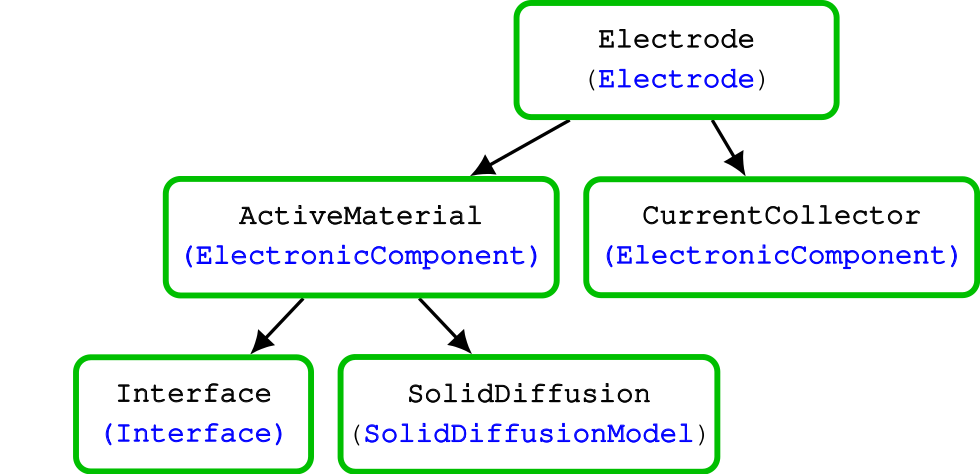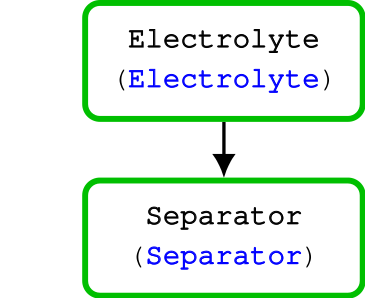Battery cell
A battery consists of two electrodes and an electrolyte. Each are implemented by a model which takes its own set of
input parameters. The convention for the input model class names is to write them using the model name followed by the
suffix InputParams. In graph above, we can see that the battery model has submodel instances as properties. The property names are in black color while the model they belong to is in blue.

- class BatteryInputParams(jsonstruct)
Input parameter class for the
Batterymodel.- G
Computational Grid
- SOC
Initial state of charge [-]
- initT
Initial temperature [T]
- NegativeElectrode
instance of
ElectrodeInputParams
- PositiveElectrode
instance of
ElectrodeInputParams
- Electrolyte
instance of
ElectrolyteInputParams
- ThermalModel
instance of
ThermalComponentInputParams
- Control
instance of
ControlModelInputParams
- couplingTerms
Coupling terms (describe the topological structure of the coupling between the components)
- use_thermal
flag : true if coupled thermal simulation should be considered
- use_particle_diffusion
flag : true if solid diffusion should be included (mainly for debugging)
Electrode components
An electrode consists of an active material, which contains an interface model and a solid diffusion model, and a current collector. Each of those components have a own set of input parameters.

Electrode
This model is derived from ElectronicComponentInputParams
- class ElectrodeInputParams(jsonstruct)
Input parameter class for
Electrodemodel- ActiveMaterial
Input parameter for the electrode active component (
ActiveMaterialInputParams)
- CurrentCollector
Input parameter for the current collector (
CurrentCollectorInputParams)
- couplingTerm
Coupling term specification
- include_current_collectors
Set to true to include current collector
Active Material
- class ActiveMaterialInputParams(jsonstruct)
Input parameter class for
ActiveMaterialmodel- Interface
Input parameter for the interface
InterfaceInputParams
- SolidDiffusion
Input parameter for the solid diffusion model
SolidDiffusionModelInputParams
- density
Density
- thermalConductivity
Intrinsic Thermal conductivity of the active component
- specificHeatCapacity
Specific Heat capacity of the active component
- electricalConductivity
Electrical conductivity / [S m^-1]
- externalCouplingTerm
structure to describe external coupling (used in absence of current collector)
- diffusionModelType
Choose between type of diffusion model (‘full’ or ‘simple’. The default is set to ‘full’)
- BruggemanCoefficient
Volume fraction of the whole material (binder and so on included)
- activeMaterialFraction
Volume fraction occupied only by the active material (default value is 1)
Interface
- class InterfaceInputParams(jsonstruct)
Input parameter class for the interface model
- G
Grid
- theta0
Lithiation value at 0% SOC [-]
- theta100
Lithiation value at 100% SOC [-]
- cmax
Maximum concentration [mol m^-3]
- k0
Reference rate constant [m^2.5 mol^-0.5 s^-1]
- Eak
Activation energy [J mol^-1]
- volumetricSurfaceArea
Volumetric surface area [m2 m^-3]
- volumeFraction
Volume fraction of the active material
- density
Density of the active material [kg m^-3]
- n
number of electron transfer
- OCP
Function to update OCP value, which is given as a struct with fields
type : “function”;
functionname : matlab function name (should be available in path)
argumentlist : [“cElectrode”, “T”, “cmax”]
- j0
Interface.updateReactionRateCoefficient. The function is given as a struct with the fields:
type = {“function”, “constant”} % if “constant” is selected, the value of k0 is used to compute reaction rate
functionname : matlab function name (should be available in path)
argumentlist = [“cElectrodeSurface”, “cmax”]
Solid Diffusion Models
- class SolidDiffusionModelInputParams(jsonstruct)
Base class for the solid diffusion models, see
FullSolidDiffusionModelInputParamsandSimplifiedSolidDiffusionModelInputParams- EaD
Activation energy [J mol^-1]
- D0
Diffusion reference constant[ m^2 s^-1]
- rp
Particle radius [m]
- volumetricSurfaceArea
Volumetric surface area [m2 m^-3]
- class FullSolidDiffusionModelInputParams(jsonstruct)
Full diffusion model (standard PXD)
- N
Number of discretization intervals in the diffusion model [-]
- np
Number of computational grid cells (typically set by parent model
ActiveMaterial)
- volumeFraction
Volume Fraction (typically set by parent model
ActiveMaterial)
- activeMaterialFraction
Active Material Fraction (typically set by parent model
ActiveMaterial)
- D
Function to update D value given as a struct with fields - D.type is in {‘function’, ‘constant’}. If ‘constant’ is chosen the value of D0 defined in parent class - D.functionname : matlab function name (should be available in path) - D.argumentlist = [“c”, “cmin”, “cmax”]
- cmax
maximum concentration [mol/m^3] (only needed if D is a function)
- theta0
Minimum lithiation, 0% SOC [-] (only needed if D is a function)
- theta100
Maximum lithiation, 100% SOC [-] (only needed if D is a function)
Current Collector
- class CurrentCollectorInputParams(jsonstruct)
Input parameter class for the
CurrentCollectormodel- externalCouplingTerm
coupling term specification of the current collector with external source
- thermalConductivity
Thermal conductivity of current collector
- specificHeatCapacity
Heat capacity of current collector
- density
Density of current collector [kg m^-3]
Electrolyte components

- class ElectrolyteInputParams(jsonstruct)
Input parameter class for
Electrolytemodel- compnames
Names of the components in the electrolyte
- sp
Structure given properties of each component
- Separator
Input parameter for the separator (
SeparatorInputParams)
- specificHeatCapacity
Specific Heat capacity of the electrolyte
- Conductivity
Density [kg m^-3] (Note : only of the liquid part, the density of the separator is given there)
- class SeparatorInputParams(jsonstruct)
Input parameter class for
Separatormodel- porosity
Porosity [-]
- thermalConductivity
Intrinsic Thermal conductivity of the electrolyte
- specificHeatCapacity
Specific Heat capacity of the electrolyte
- density
Density [kg m^-3]
Electronic Component
Base model for all component with a electrical potential and a charge conservation equation